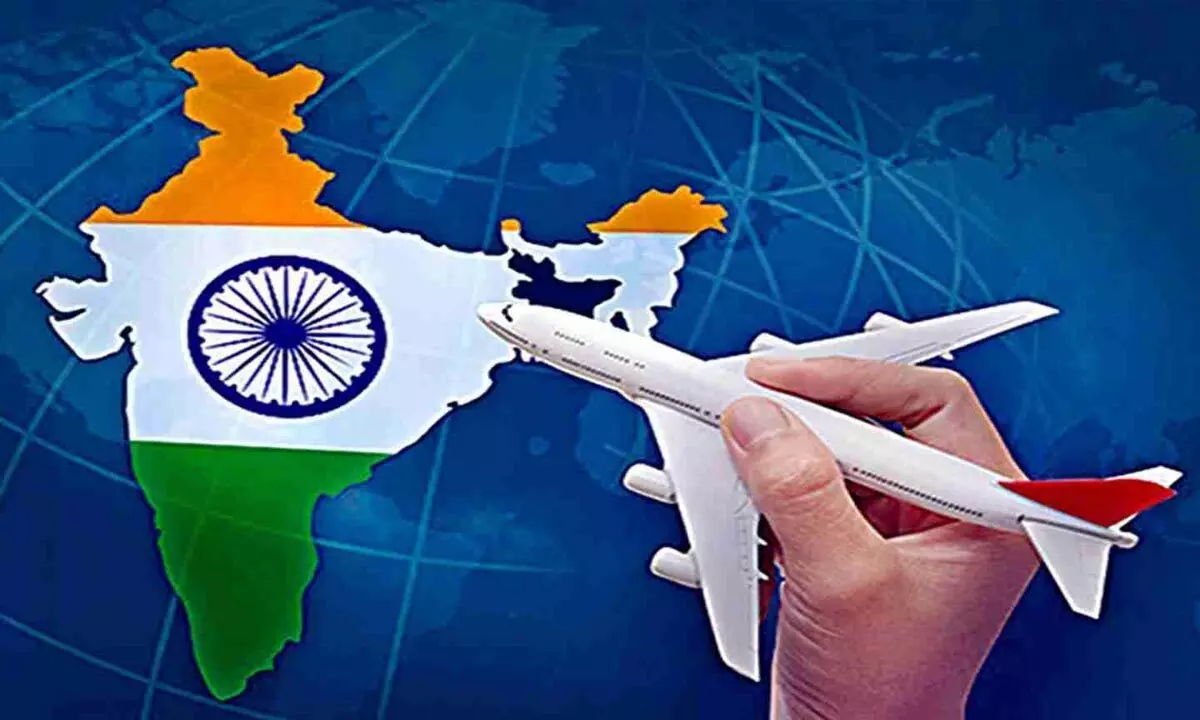Live
- All you need to know about PAN 2.0
- Akasa Air redefines travel experience with industry-first offerings
- MP: Residents stage protests against liquor shop in Indore
- Telugu Actor Shri Tej Booked for Alleged Cheating and False Promise of Marriage in Live-in Relationship
- Toyota Kirloskar Motor Celebrates 1 Lakh Urban Cruiser Hyryder on Indian Road
- MLS: New York City FC part ways with head coach Nick Cushing
- Delhi CM says Centre cutting AAP voters’ names from rolls, BJP hits back
- Hyderabad Metro Rail Phase-II Works to Begin in Old City in January 2025
- Odisha: 668 persons killed in human-elephant conflicts in last three years
- DEFENDER JOURNEYS: TO EMBARK ON ITS THIRD EDITION FROM NOVEMBER 2024
Just In
Aviation industry is on the cusp of growth


Aviation industry is on the cusp of growth
Aiming to fly higher, India keen on modernising its fleet with more fuel-efficient next-generation airplanes
India has become the thirdlargest domestic market in the world after the United States and China, with more people choosing to travel by air than ever before. The domestic air traffic picked up pace during FY22-23 and is expected to touch around 97 percent of the pre-Covid levels.
With a net induction of 132 planes next fiscal, the total fleet of all carriers is likely to be around 816 aircraft.
Highlighting the potential for growth, Civil Aviation Minister Jyotiraditya Scindia said that it was time for India to look at manufacturing aerospace products. He added that the aggregate fleet size of domestic carriers is estimated to reach around 2,000 aircraft over the next five to seven years.He emphasized the expansion of drone industry, stating that it is projected to reach a value of approximately $40 billion by 2030 and boast of 250 million employees. In the past eight years, the number of operational airports in the country has risen from 74 to 140. The government plans to develop and operationalise 220 airports in the next five years. India is currently the seventh largest civil aviation market in the world and is expected to become the thirdlargest within the next 10 years.
The country's airlines will add seven per cent more supply in the first half of 2023, compared to 2019. Due to the rapid growth of its domestic traffic, Boeing forecasts that 90% of new airplane deliveries to India will be for single-aisle airplanes like the 737 MAX over the next 20 years by when India is expected to require approximately 2,210 new airplanes. Of them, 1,983 units will be for single-aisle jets while 227 or 10% of new airplane deliveries will be for wide-body airplanes.
"The Indian market is recovering rapidly and its domestic capacity has exceeded the 2019 levels. The domestic traffic is expected to double by the end of this decade," said Dave Schulte, Boeing Commercial Marketing managing director for Asia Pacific. "Indian carriers will outpace global growth at nearly seven per cent and more than 80% of new airplane deliveries to this market will be for growth, while 20% of new airplanes will be for replacement of aging jets. This trend exemplifies India's commitment to modernising its fleet with more sustainable and fuel-efficient next-generation airplanes."
In addition, the India cargo market will also continue to expand over the next two decades to meet the demand. The cargo fleet will grow from about 15 airplanes in 2023 to about 80 by 2041. These will predominantly be the converted narrow-body sized aircraft to support domestic and regional growth, as well as a number of production and conversion wide-body freighters to support global operations. Air India made a historic announcement on February 14 by signing a deal with Boeing and Airbus to buy 470 aircraft worth $ 70 billion, marking the largest order in aviation history. This is also Air India's first order since 2005 and comes at a time when the Indian aviation industry is seeing a surge in passenger traffic.
The entry of low-cost carriers like IndiGo and SpiceJet has made air travel more affordable for a large population. This has led to an increase in passenger traffic, particularly on domestic routes. In addition, airlines have introduced various incentives and loyalty programs to attract and retain customers.
Approximately, 37 percent of affluent Indians plan to travel in groups in the upcoming months, according to the latest findings by YouGov, a market research and data analytics company. Almost two in five have traveled with a wider group in the past 12 months and the same proportion intends to do so in the next few months. Another travel activity that affluent Indians are keen to undertake is taking a longer holiday than usual or taking a cruise.
The Union Budget 2023-24 allocated Rs. 1,244.07 crore for the regional connectivity scheme (UDAN). The National Civil Aviation Policy is another initiative aimed at promoting growth in the aviation sector by providing incentives for the development of airport infrastructure, reducing taxes, and simplifying regulations. With up to 100 percent FDI permitted in Greenfield and existing airport projects and for MRO (maintenance and repair organisations) under the automatic route, India is attracting investors to the sector.
To meet the demands of the rising customer base, almost 200 airports would need to be constructed. More than 1,50,000 acres of land would need to be developed for the Indian airports. A cost of more than Rs. 3,375 crore would be required for various civil aviation schemes.

© 2024 Hyderabad Media House Limited/The Hans India. All rights reserved. Powered by hocalwire.com






